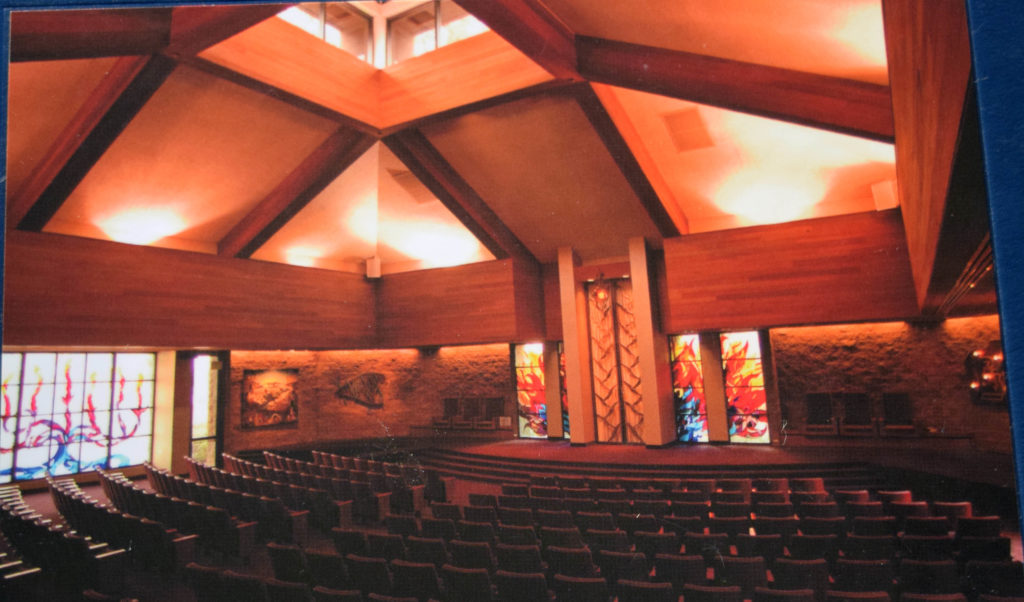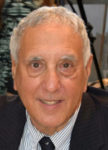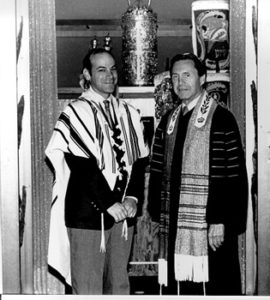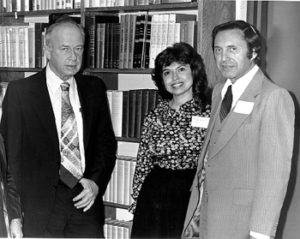
By Donald H. Harrison

SAN DIEGO – The prayer space within the Tifereth Israel Synagogue sanctuary that the late Rabbi Dr. Aaron Gold helped to design and where he spent much of his life leading prayer services, now has two new names. One is Ohel Aharon, or the Tent of Aaron; the other is “The Rabbi Aaron S. Gold Beit Tefilah,” meaning the Rabbi Aaron S. Gold Prayer Space.
While the prayer space is named for Gold, the overall sanctuary still is named for previous donors, the late Charles and Ethel Silverman.
The names honoring Gold were announced during the Conservative synagogue’s annual Abraham and Anne Ratner Scholar-in-Residence Weekend during which Cantor Hanan Leberman, an American who made Aliyah to Israel, spoke and chanted during Friday evening and Saturday morning Shabbat services, then concertized with Hebraic, Broadway, and Operatic tunes on Saturday evening, March 10.

Rabbi Leonard Rosenthal, who succeeded Rabbi Gold as spiritual leader of Tifereth Israel Synagogue, and is now himself retired, said Gold’s widow, Jeanne, told him she would like to make a substantial gift to the synagogue, located at 6660 Cowles Mountain Boulevard.
“We searched for an appropriate way to honor her gift and Rabbi Gold’s Legacy and concluded that his presence was most felt and he affected the most people here in this sanctuary,” Rosenthal said. “It was here that he most shared his insight, knowledge, analysis, warmth, and love. This sanctuary was his spiritual home.”
Rosenthal added that, “We will no longer refer to this space as our ‘sanctuary,’ but rather as ‘Ohel Aharon’ or ‘The Rabbi Aaron S. Gold Beit Tefilah.’ I cannot think of a more beautiful way to acknowledge, remember, and celebrate his legacy.”
Further, said Rosenthal, “Tonight [March 9, 2018], for the first time in Ohel Aharon, may all of us be inspired to be disciples of Aaron, loving peace and pursuing peace, loving humankind and bringing them close to Torah.”
In response, Jeanne Gold paid tribute to Cantor Leberman; to Rabbi and Judy Rosenthal, who chaired the weekend; to Rabbi Joshua Dorsch, who is her late husband’s second successor, and to synagogue senior staff members Lori Kurtz and Beth Klareich, who handled the many internal arrangements to make the weekend possible.

In an interview afterwards, Jeanne Gold said her gift, part of which was immediate and part of which is reserved for the synagogue after her death, will help to underwrite the salaries of rabbis, and generally to help in the running of the synagogue. “It is a gift in perpetuity, an endowment,” she said. Previously she had established in Rabbi Gold’s memory a scholarship fund enabling students Tifereth Israel teens to travel to Israel.
“The phrase ‘Ohel Aharon’ is so beautiful to me;’ it’s an idea that evolved,” Jeanne Gold said. “A few months ago, it simply would have been the sanctuary dedicated in memory of Aaron Gold.” She said the new name will be placed on a double-door entrance to the Ohel Aharon, and also on a plaque inside.
She recalled that her husband had been very much involved in the design of the sanctuary, which seats some 300 persons but can be made into a much larger space, seating up to 1,500, by opening the movable wall between it and the social hall. He was particularly proud of the stained-glass windows depicting the Burning Bush behind the pulpit that were designed by artist Leslie Perlis and of a special cabinet containing a Holocaust Torah, which Jeanne played a role in transporting.
She said that while she was working at Ryan Aircraft she received a call from her husband, the rabbi, saying that a Torah once seized by the Nazis and later liberated to a synagogue and museum in Westminster, England, was soon to land at San Diego International Airport. Would she please pick it up. “Having it in the back seat of my car was a very moving experience,” she said.
Today, the Torah is covered in a special mantle designed by the artist Jackie Jacobs, depicting butterflies rising from a darkened field surrounded by barbed wire into the sunlight of freedom – an homage to the poem ‘I Never Saw Another Butterfly’ by Pavel Friedmann, who was incarcerated at the Theresienstadt ghetto and concentration camp.
Of her late husband, she said, “He was a visionary, so creative, always looking for something else, something beautiful, something meaningful.”
The ceiling of the sanctuary is made of cedar, recalling the Cedars of Lebanon of the Bible.
In that sanctuary, she said, Rabbi Gold celebrated his 13th or bar mitzvah year as a rabbi, in a ceremony attended by some of his Orthodox relatives from the East Coast. One member of the family, she remembered, sat in Gold’s office during the service rather than sit with the congregation because it had mixed seating for men and women.
“I remember the special celebrations at our synagogue as well, for example, the time that Ezra Taft Benson, head of the Mormon Church came to visit; and another time when Aaron exchanged visits with (Roman Catholic) Bishop Leo Maher.” Maher delivered a sermon in the Ohel Aharon, and Gold preached a return sermon at the Church of the Immaculata on the University of San Diego campus.
Because the dedication ceremony was held during the intermission of Leberman’s concert, Gold modestly decided not to take too much time in her remarks, but had she more time, she said, she would have retold the story of how she met the rabbi.
She said her Aunt Rose and some of her friends had formed a “Let’s Get Jeanne Fixed Up” fan club, and told her about Rabbi Gold, who then was serving as an associate rabbi at Tifereth Israel’s previous home at 30th and Howard Streets.
“I waited a few weeks and he never called, but one night, while I was on my way to a meeting, he called me,” Jeanne related. “We talked several hours, and he told me how busy he was—even reading his schedule. That Friday night I went to his synagogue with my friend Sharon, and that happened to be the ORT Shabbat [ORT is a Jewish organization specializing in job training] so there were many women there who weren’t members. An elderly man, Cantor Eugene Goldberger, came on the pulpit, and I thought to myself ‘he’s too old for me,’ but then a younger man came on, and I thought he was gorgeous. At the end of the services, there was a receiving line, and I waited until the end of the line. I said, ‘Hello Rabbi, I’m Jeanne Weissbuch,” and Joel Sucov who was behind me joked, “And I’m her chaperone.” The rabbi said, “Can I take over for the evening?” He told me during the Oneg Shabbat that he was expected to mingle with the congregants so when someone came up to talk to him, I would walk away. When the evening closed he asked me out for the following night, Saturday night, after Shabbat.”
They went with some friends to an engagement party, where, after being asked to do so, Gold gave a toast to the newly engaged couple. “He gave a glowing toast after which they all applauded, and I was totally impressed. I said to him, ‘you know rabbi, I would like you to officiate at my wedding.’ And he said, ‘How do you know, I won’t be the groom?’”
They met before Thanksgiving, they became engaged the following Valentine’s Day, and were married in June, time enough for Jeanne to observe the planning and dedication that went into the creation of the synagogue and education center on Cowles Mountain.
Gold’s father composed liturgical music, and according to Jeanne, the son would frequently sing or hum it as they drove together in a car. The evening in which Cantor Leberman, occasionally in duet with soprano Carolyne DalMonte, and accompanied on piano by Janie Prim, was in Jeanne’s estimate “the perfect occasion” for the dedication. “Aaron would have loved it.”
Gold served the congregation for 18 years, becoming its emeritus rabbi in 1992. Unable to stay retired, he subsequently served in the pulpits of Ner Tamid Synagogue in Poway, Beth Sholom in Chula Vista, and Beth Emet in Anaheim. He died in 2001 in the San Diego suburb of La Mesa, where he and Jeanne made their home.
*
Harrison is editor of San Diego Jewish World. He may be contacted via donald.harrison@sdjewishworld.com